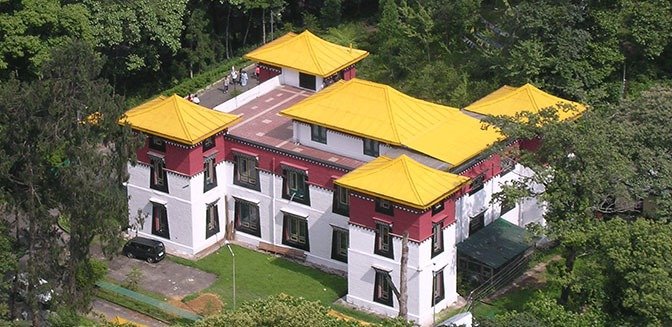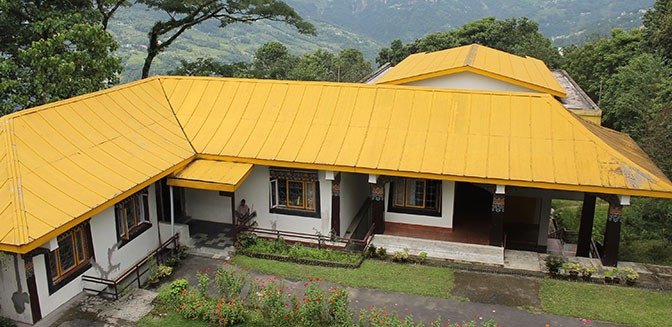


Latest News
1. Admission notice for Masters in Buddhist and Tibetan Studies 2025-26 ![]()
2.A special exhibition in Gangtok about and extraordinary friendship result ![]()
3.BSRMS (4th year) result ![]() (Published on: 11th Sep, 2024)
(Published on: 11th Sep, 2024)
4. BSRMS (3rd year) result ![]() (Published on: 11th Sep, 2024)
(Published on: 11th Sep, 2024)
5. Drokpa: Grazing on the Border, the Yak Herders of North Sikkim (Published on: Sept, 2024)
6. Bulletin of Tibetology 2024
7. Important Notice (Memorandum)
Latest News
Admission notice for Masters in Buddhist and Tibetan Studies 2025-26 
A SPECIAL EXHIBITION IN GANGTOK ABOUT AN EXTRAORDINARY FRIENDSHIP ![]()
Drokpa: Grazing on the Border, the Yak Herders of North Sikkim ![]()
Extension of registration of NCISM NEET SR UG 2024
Bulletin of Tibetology 2024
Visitor Information
The Namgyal Institute of Tibetology (NIT), Gangtok, Sikkim is an important reference centre in the world of Buddhist scholarship. It houses a museum, a Tibetan library and a general reference and research centre on Tibet, Sikkim and the Himalayas.
The Institute is located in Deorali, to the south of central Gangtok. The opening hours are from 10 am to 4:30 pm from Monday to Saturday. It is closed on Sundays and on official government holidays.
Entrance fee to the museum and the libraries is Rs. 25/-.
The Institute is located in beautiful sylvan surroundings and extensive grounds. Close by the main premises of the NIT lies a memorial park in honour of the last king of Sikkim. Amidst the beautiful surroundings stands the bronze statue of Chogyal Palden Thondup Namgyal of Sikkim.
About Us

The Namgyal Institute of Tibetology was established in the year 1958. Located in Deorali, Gangtok, East Sikkim, the main building of the Institute is an imposing monument and a splendid example of Sikkimese architecture. The Namgyal Institute holds a museum, two libraries and a research centre. The 12th Chogyal (king) of Sikkim, Palden Thondup Namgyal, envisioned and helped established the Namgyal Institute as its Founder President. The site on which the Institute is established was donated by his father, the 11th Chogyal Tashi Namgyal, in memory of his departed son Paljor Namgyal.
The Institute’s foundation stone was laid by the 14th Dalai Lama on the 10th of February, 1957, and the Institute was declared open by the late Prime Minister of India Pandit Jawaharlal Nehru on the 1st of October, 1958.
The initial purpose of the Institute’s foundation was to preserve the invaluable texts on history, religion, literature and science brought from Tibet at the time of the region’s political turmoil in the 1950’s. The collection later expanded to includes thangkas, statues, xylographs, ritual instruments and other treasures.
The Namgyal Institute of Tibetology was established in the year 1958. Located in Deorali, Gangtok, East Sikkim, the main building of the Institute is an imposing monument and a splendid example of Sikkimese architecture. The Namgyal Institute holds a museum, two libraries and a research centre. The 12th Chogyal (king) of Sikkim, Palden Thondup Namgyal, envisioned and helped established the Namgyal Institute as its Founder President. The site on which the Institute is established was donated by his father, the 11th Chogyal Tashi Namgyal, in memory of his departed son Paljor Namgyal.
The Institute’s foundation stone was laid by the 14th Dalai Lama on the 10th of February, 1957, and the Institute was declared open by the late Prime Minister of India Pandit Jawaharlal Nehru on the 1st of October, 1958.
The initial purpose of the Institute’s foundation was to preserve the invaluable texts on history, religion, literature and science brought from Tibet at the time of the region’s political turmoil in the 1950’s. The collection later expanded to includes thangkas, statues, xylographs, ritual instruments and other treasures.


Since its inception, the Namgyal Institute of Tibetology sponsored and promoted research on Mahayana Buddhism, religious art and related fields, and more recently, on the Buddhist history, language and culture of Sikkim and other Himalayan regions.
The Institute holds two libraries. The Tibetan Library, which has one of the largest collections of Tibetan texts in the world, and the General Library, which holds an important collection of books, in English and other languages, on Buddhism and the Himalayan region. Everybody can access both libraries.
The Museum holds an important collection of Mahayana Buddhist art in the form of thangkas (painted scrolls), statues, and ritual objects, in addition to rare Buddhist texts written in various languages and other antiques. The museum is open to the public.
In 2018, the Namgyal Institute of Tibetology established a department for the study of Tibetan Medicine (BSRMS), which is affiliated to the Central University of Sikkim. It is popularly known as ‘Sowa Rigpa’ or ‘Amji Course’. Sixty students have so far enrolled with the first class of 2018 currently in its internship year.
In 2019, the Institute initiated a two years Master’s program in Buddhist and Tibetan Studies. The first two classes of 2019 and 2020 have completed the program, which is also affiliated to the Central University of Sikkim.
Latest News

Sikkim Video Archive
Feb 25, 2017
The film illustrates the changes the Lepcha of the Dzongu reserve, North Sikkim, have been through in the last 60 years. From the 1940s, the Lepcha of Tingvong village gradually abandoned hunting, gathering and the slash and burn cultivation of dry rice, and became settled agriculturalists.
Feb 28, 2017
Every winter, over a period of six days, the lamas of Lingthem’s village monastery hold their annual cham. These dramatic ritual masked dances impart elementary Buddhist teachings while providing entertainment to villagers. Their main purpose is to remove obstacles and ward off misfortune for the village, its inhabitants and the monastery.
Mar 8, 2017
Every winter, the lamas of Phensang’s village monastery hold their annual cham. These dramatic ritual masked dances impart elementary Buddhist teachings while providing entertainment to villagers.
Mar 2, 2017
Ongdala is an eight year old tulku or reincarnate lama. The film follows his public examination which took place in the Sikkimese village of Lachen in January 2007. Ongdala recites his prayers in the presence of the village assembly and is then initiated and welcomed as a lama of the Lachen monastery.
Apr 16, 2024
This film is about an almost forgotten Buddhist ritual in Sikkim. Once a year during the summer, the lamas of Tashiding monastery perform the Chap Chu. The ritual commemorates how, in the 17th century, a Tibetan lama Ngadak Senpa Chenpo miraculously produced two drinking water sources for Silnon and Tashiding villages in West Sikkim.
Mar 8, 2017
Ritual Journeys is an intimate portrait of Merayk, an 80 years old Lepcha shaman or Padim. Merayk lives with his family in Dzongu, a Lepcha reserve in North Sikkim, Eastern Himalayas. He performs healing rituals for individuals as well as rituals for the well-being of the household, the clan and his village community.
Mar 9, 2017
Every winter, the Bumchu or ‘sacred water ritual’ of Tashiding is held on the full moon night of the first month of the lunar calendar, usually falling in February or early March.
Feb 28, 2017
Pang Lhabsol, Sikkim’s most important indigenous celebration, consists of a series of rituals and monastic dances held in honour of Sikkim’s chief mountain deity, Khangchendzonga, and all the land’s guardian deities. Considered the true custodian of the land, its people and resources,
Jun 15, 2017
The Lhon Drokpas consist of 12 families of Tibetan yak herders settled in the upper reaches of the Lachen Valley where they have grazed their herds of yak and sheep along and across the Sikkim-Tibet border for generations.
Jul 15, 2022
Dilgo Khyentse Rinpoche (1910-1991), one of the greatest realized masters of the 20th century, was tutor to the 14th Dalai Lama and to the Bhutanese Royal Family. Dilgo Khyentse Rinpoche was reborn in 1993 in Nepal and is now known as Dilgo Khyentse Yangsi Rinpoche.
Feb 22, 2022
Kunchok Lodroe, better known as Ajo Garpo, spent over 50 years of his life carving sacred Buddhist mantras on stones at Tashiding monastery, one of Sikkim’s most sacred locations...